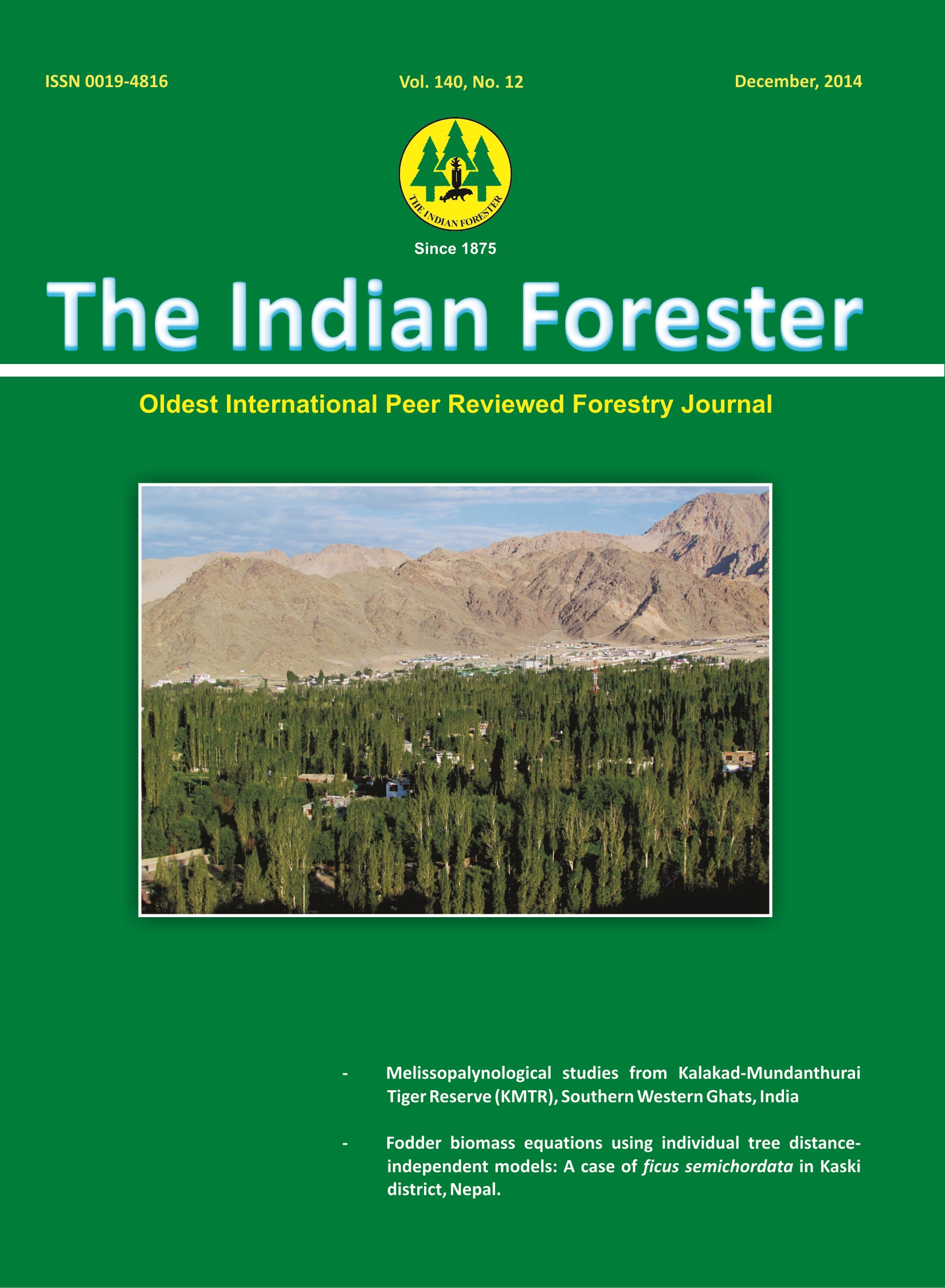Effect of Foliar Application of GA3 , Ethrel and Copper Sulphate on Fruit and Yield of Jatropha Curcas L.
DOI:
https://doi.org/10.36808/if/2014/v140i12/55258Keywords:
Jatropha curcas, GA3, Ethrel, Copper Sulphate and yieldAbstract
Jatropha curcas, a monoecious perennial biofuel shrub belonging to the family Euphorbiaceae, has few female flowers, which is one of the most important reasons for its poor seed yield. This study was undertaken to determine the effect of foliar application of GA<SUB>3</SUB> (25, 50,100ppm), Ethrel (1500, 2000, 2500ppm), Copper sulphate (0.10, 0.20, 0.50ppm) on fruit 3 and seed yield of J. curcas. Exogenous application GA<SUB>3</SUB> 50ppm resulted in significantly increased number of fruits per 3 inflorescence (3.71) , number of fruits per plant (88.00), and total fruits (453.33) as well as 355.55 gm seed yield per th th plants in plant treated with GA 50ppm as compared to control between 9<SUP>th</SUP> to 14<SUP>th</SUP> spray. The Male: Female flower ratio 3 th was lowest at 14<SUP>th</SUP> spray stage under majority of treatments indicating increased number of female flowers which is ultimately reflected by increased fruit and seed yield.References
Arteca R.N. and Arteca J.M.(2007). Heavy-metal-induced ethylene production in Arabidopsis thaliana. J. Plant Physiol., 164 (11):1480-8.
Arora S.K. and Pratap P.S. (1988). Effect of plant growth regulators on vegetative growth, flowering fruit yield in pumpkin (Cucurbita moschata Duch. Ex. Poir). Haryana Agric. Uni. J. Res., 18(4):284-290.
Dehgan B. and Webster G.L. (1979). Morphology and infrageneric relationships of the genus Jatropha (Euphorbiaceae). Califonia Publicaton Boanyt., 74:1–73.
Divakara B.N., Upadhyaya H.D., Wani S.P. and Gowda C.L.L. (2010).Biology and genetic improvement of Jatropha curcas L.: a review. Applied Energy, 87:732-742.
Ghosh A., Chikara J., Chaudhary D., Prakash A., Boricha G., and Zala A. (2010). Paclobutrazol arrests vegetative growth and unveils unexpressed yield potential of Jatropha curcas. J. Plant Growth Regul., 29:307–315.
Hirayama and Alonso. (2000). Ethylene Capture a Metal. Metal Ions are involved in Ethylene Perception and Signal Transduction.(Reviw). Plant Cell Physiology, 41:548-555.
Jack T. (2004). Molecular and genetic mechanisms of floral control. Plant Cell, 16:1-17
Jongschaap R., Corre W. Bindraban P. and Brandenburg W. (2007). Claims and facts on Jatropha curcas L. Global Jatropha curcas evaluation, breeding and propagation programme. Report 158. Plant Research International BV, Wageningen, Netherlands.
Joshi G., Shukla A. and Shukla A. (2011). Synergistic response of auxin and ethylene on physiology of Jatropha curcas L. Brailian. J. Plant Physiology. 23(1): 67-77.
Kumar A. and Sharma S. (2008). An evaluation of multipurpose oil seed crop for industrial uses (Jatropha curcas L.): A review. Indian Crop Prod., 28: 1–10.
Liu H. Deng and Y. Liao J. (2008). Floral organogenesis of three species of Jatropha (Euphorbiaceae). J. Syst. Evol., 46:53–61.
Love J., Bjorklund S. and Vahalab J. (2009). Ethylene is an endogenous stimulator of cell division in the cambial meristem of Populus. Proc. Natl. Acad. Sci.USA, 106 : 5984–5989.
Makkar H.R.S. and Becker K. (2009). Jatropha curcas, a promising crop for the generation of biodiesel and value-added co-products. European J. Lipid Sci. Technology, 111:773–787.
Makwana V., Shukla P. and Robin P. (2010). Comparing potential of GA and 2, 4-D in increasing fruit yield from Jatropha curcas. J. Biofuels, 1:157-162.
Panse V.G. and Sukhatme P.V. (1967). Statistical methods for agricultural workers. ICAR Pub.,New Delhi.396.
Raju A.J.S. and Ezradanam V. (2002). Pollination ecology and fruiting behaviour in a monoecious species, Jatropha curcas Lin. (Euphorbiaceae). Current Science, 83 : 1395–1398.
Rao G.R., Korwar G.R., Arun K.S. and Ramakrishna Y. S. (2008).Genetic associations, variability and diversity in seed characters, growth, reproductive phenology and yield in Jatropha curcas (L.) accessions. Trees, 22:697-709.
Sanderson K. (2009). Wonder weed plans fail to flourish. Nature, 461:328–329.
Santner A. and Calderon V.A. (2009). Plant hormones are versatile chemical regulators of plant growth. Nat. Chem. Biol., 5:301–307
Sunil N., Varaprasad K.S., Sivaraj N., Kumar T.S., Abraham B., Tewari J. P., Dwivedi H.D., Pathak M., and Srivastava S.K. (2007). Incidence of a mosaic disease in Jatropha curcas Lin. from eastern Uttar Pradesh. Curr. Sci., 93:1048–1049.
Zeevaart J.A.D. and Talon M. (1991). Gibberellin mutants in Arabidopsis thaliana. In: Plant Growth Regulation, (CM Karssen et al., eds), Kluwer, Amsterdam.
Downloads
Downloads
Published
How to Cite
Issue
Section
License
Unless otherwise stated, copyright or similar rights in all materials presented on the site, including graphical images, are owned by Indian Forester.





